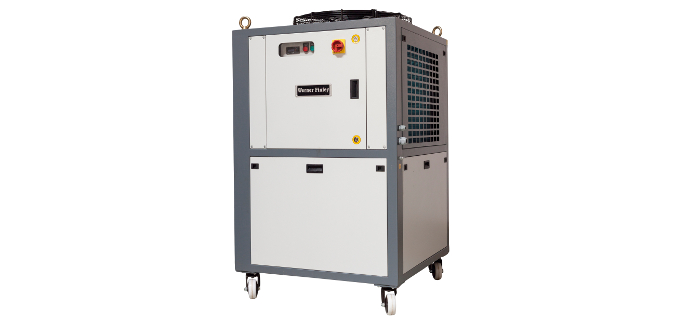- Cooling capacity range : 1.75 kW to 1050 kW
- Fluid : Soft Water / water + glycol solution
- Refrigerant : R407c / R134a
- Operating ambient temperature range : +10 to + 50C
- Best fluid outlet temperature : 15degc, At ambient : 35degc & ∆T : 5 Deg C
- Condenser Type : Air-Cooled, Fin & Tube
- Evaporator Type : Brazed Plate Heat Exchanger
- Operating environment : Indoor / Out door - Shelter from rain, dust, insects, humidity, sunlight
- Power supply : 1 PH / 3 PH, 220V / 415 V, AC, 50/60 HZ
- MOC of wetted parts : SS 202 / 304 / 316
- Fluid loop : Open loop with media tank in the circuit
- Noise level : < 85 db
- Life expectancy : 10-15 years
Air Cooled Scroll Chillers
I FLO and I NOC Scroll Chillers
Both these types of chillers make use of untreated, dirty water as a cooling media and contain a shell and tube type evaporator. The I FLO contains R 407C as a refrigerant and works in conditions up to 45°C, while the I NOC uses R 134a in conditions upto 55°C. These chillers are used in applications in the fields of plastics, food and beverages, chemicals and pharmaceuticals, textiles, brewery, cement and concrete batching.

Apart from the pre-installed standard components, all the scroll chillers can be fitted with additional components, allowing them to be customised to a specific need and benefit its application with greater accuracy. The available add-on features include a flow switch or indicator, flow meter, remote control panel, energy meter and audio-visual alarm. One can choose the chiller most suited to their target application and further customise it to fit their needs.
Our Applications
Solar and Wind Energy, Health Care, Data Center, Power Electronics, Machine Tool, Induction Heating, Welding, Hydraulic Oil Cooling, Paint Manufacture, Pharma, Chemical, X-Ray Spectrometer, Vacuum Systems, Breweries, Food Processing, Plastic, Concrete Batching




